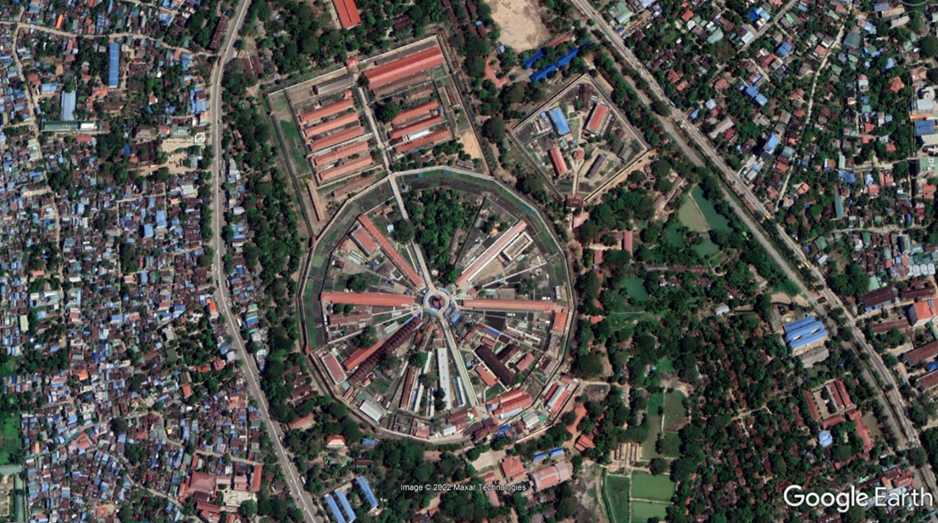
Three years on from the military coup in Myanmar, a new investigation by CIR’s Myanmar Witness project uses satellite imagery and open source data to map the country’s prisons and labour camps.
The analysis reveals how Myanmar’s prison complex has been expanded and developed since February 2021, when the military ousted elected leader Aung San Suu Kyi, triggering a wave of protests across the country.
Since then, reported arrests of political prisoners – including human rights advocates and protesters – have been widespread.
As of 31 January 2024, the Assistance Association for Political Prisoners (AAPP) has reported that nearly 26,000 people have been arrested since the coup, with just under 20,000 estimated to still be in detention.
“As activists and civil society continue to be arrested and detained by the Myanmar military – in many cases arbitrarily and without trial – this report reveals the scale of growth in the regime’s repressive prison complex,” said Matt Lawrence, project director of Myanmar Witness.
“Myanmar Witness identified over 100 prisons and labour camps and found expanded, secure perimeter or new secure areas in almost half of the prisons we mapped.
“Our methodology may well underestimate the expansion of prisoner accommodation. Open source data does not allow us to see inside every new building nor ascertain what every block is used for.”
Investigators used data from the country’s official prisons department website and cross-checked details with satellite imagery to document Myanmar’s prisons and labour camps in an open source map.
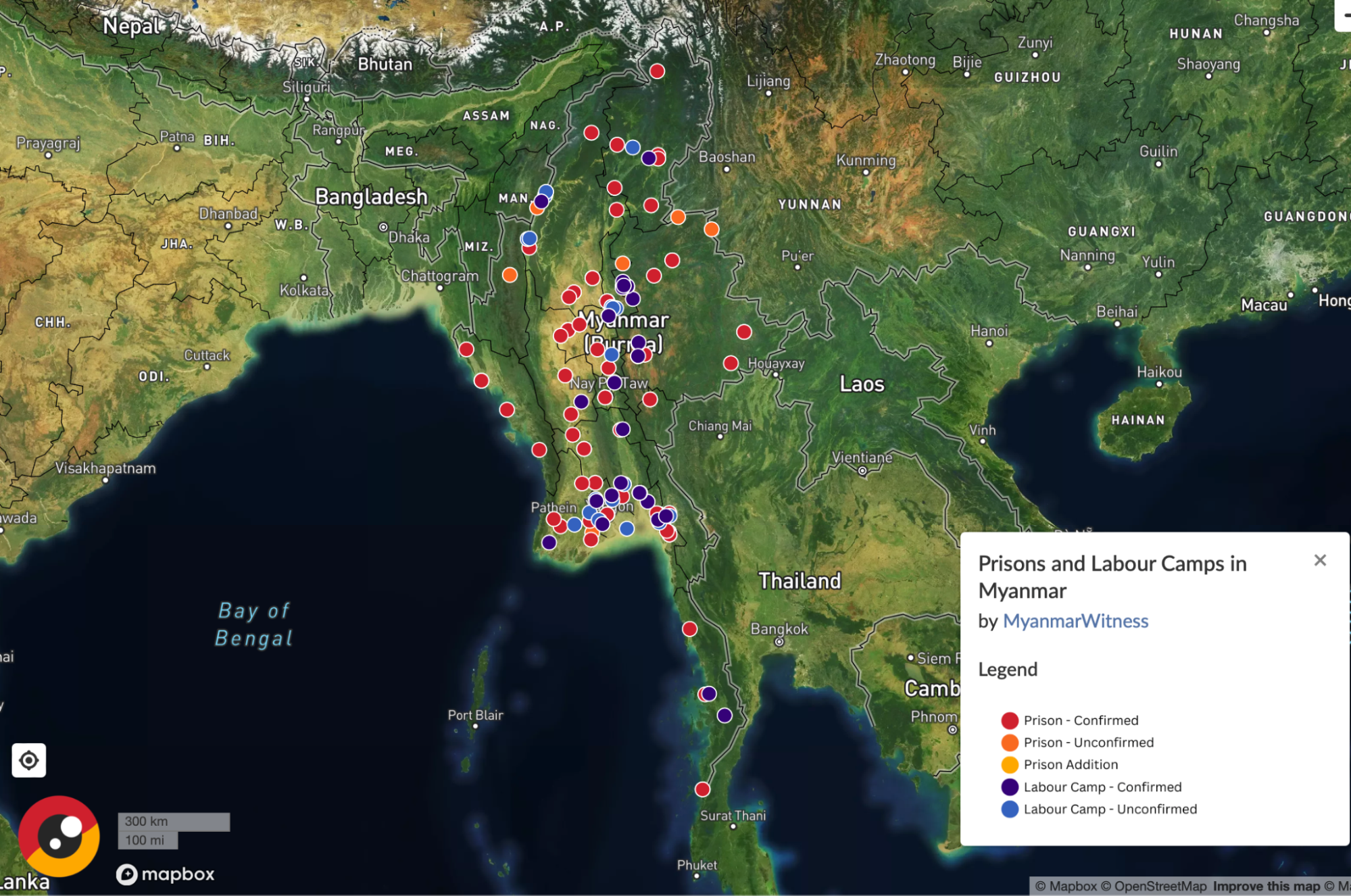
Map of confirmed and unconfirmed prison and labour camps across Myanmar.
The full, interactive map can be viewed here.
They then analysed the satellite imagery to monitor changes in the structures and features of the prison buildings or, in the case of labour camps, the activity surrounding the sites.
The report finds that nearly half of the 59 prisons recorded by Myanmar Witness were expanded in some way – either through new buildings erected outside of the prison perimeter or through large perimeter expansions. Satellite imagery revealed high levels of security surrounding the buildings – described in the report as “additions” – indicating their purpose is to detain yet more prisoners in the country.
Investigators also identified two new prisons built since the coup, beginning construction in 2021 and 2022. According to Radio Free Asia, the new Mawlamyine prison, located in Mon state, was built in response to the mass arrests of protesters following the coup.
Satellite imagery of a third new prison was also collected by investigators. The prison is located in Ayeyarwady State and appears to be near completion in recent imagery.
The report provides a glimpse of the scale of resources directed into Myanmar’s prison system since the February 2021 coup. According to Myanmar Witness, 68% of prisons saw development or maintenance, including new roofs, gatehouse upgrades, added watchtowers, and updated structures, though the report points out it is unclear if such changes amount to additional prisoner accommodation.
Subtle yet significant changes
Six case studies are covered in the report, including In Seinn, one of Myanmar’s most infamous prisons. In Seinn is located in the Yangon region and is known for its poor sanitation levels as well as reports of torture. In July 2022, four inmates were executed at the prison for allegedly plotting to carry out attacks on regime targets and killing military informants.
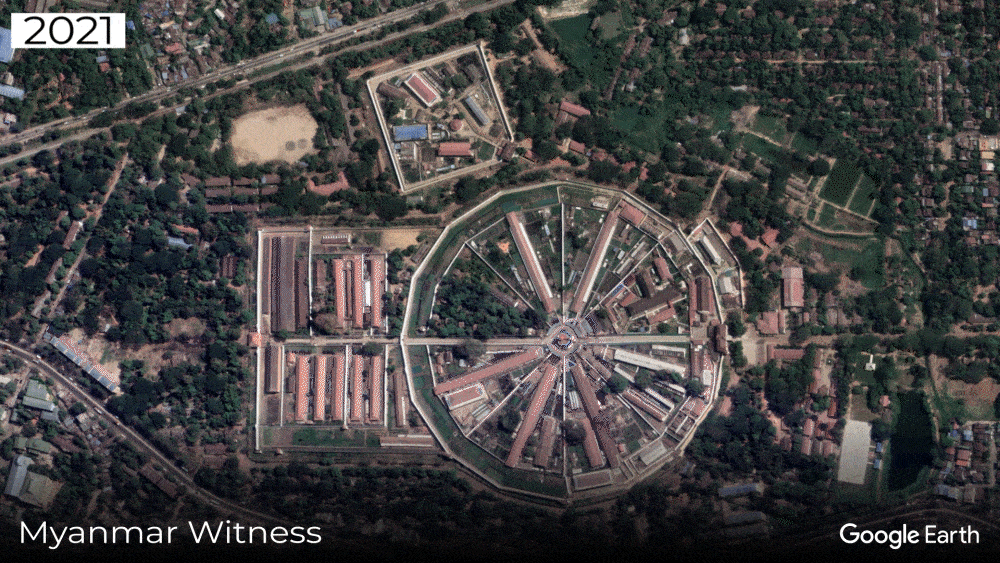
Satellite imagery of Inn Sein Prison from January 2021 to January 2023. Outlined in white are new structures and renovations built inside and around the prison perimeters. (Source: Google Earth Pro)
Investigators were able to pinpoint the reported location of the gallows where the executions were carried out. The area had no roof in satellite imagery from March 2022, but a roof appeared over the gallows in January 2023, as well as two new buildings constructed southeast of the main prison.
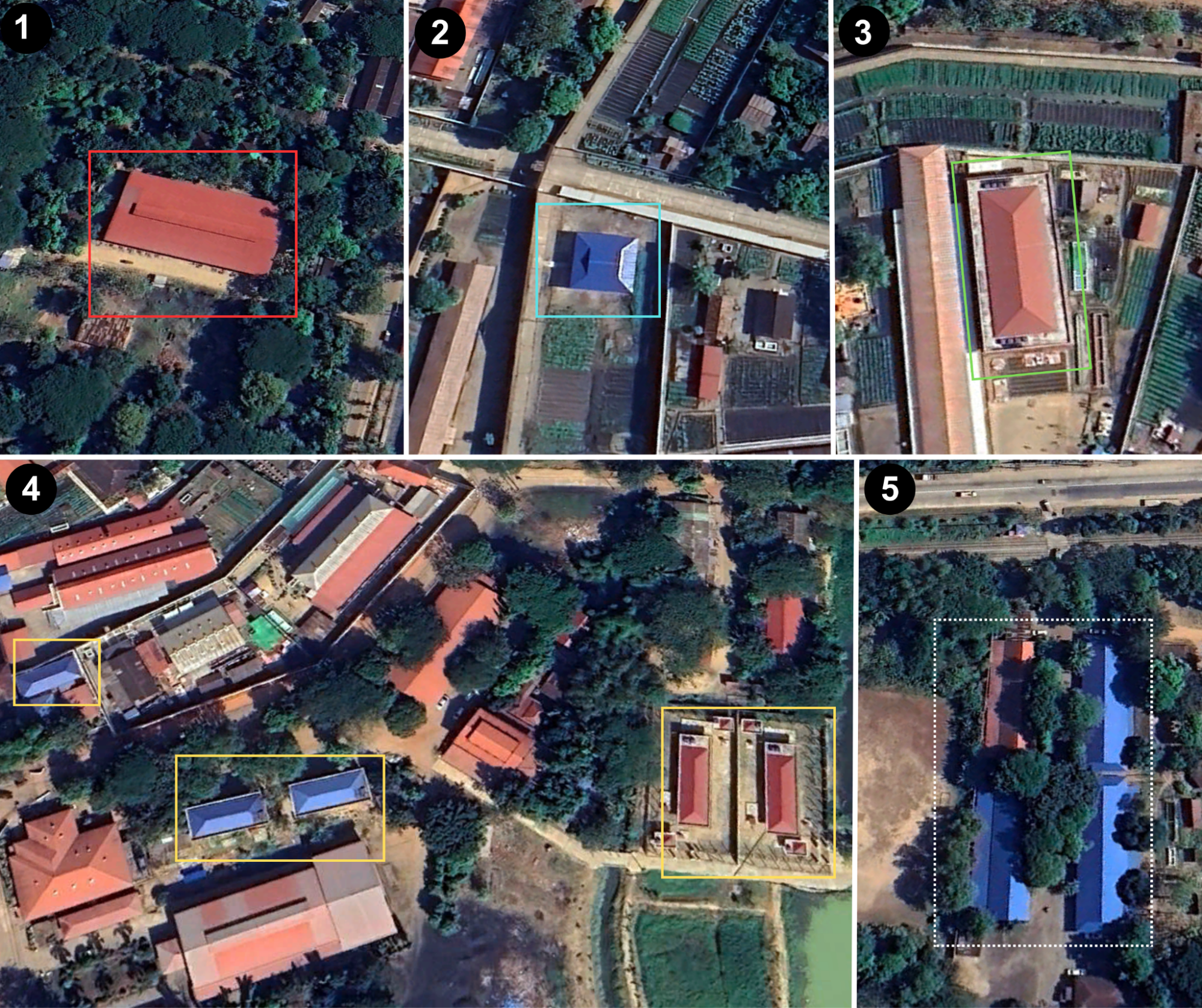
Zoomed-in satellite imagery of the Inn Sein Central Prison from January 2023 shows several roof or building upgrades and new builds. In the second box, outlined in blue, a new gallows roof can be seen. (map source: Google Earth Pro)
Aung San Suu Kyi and other political prisoners
Naypyitaw Prison – built just outside of the newly designated capital Naypyitaw between 2015 and 2017 – is also included as a case study in the report. Satellite imagery analysed by investigators shows several new external buildings appearing in February 2022 and April 2023.
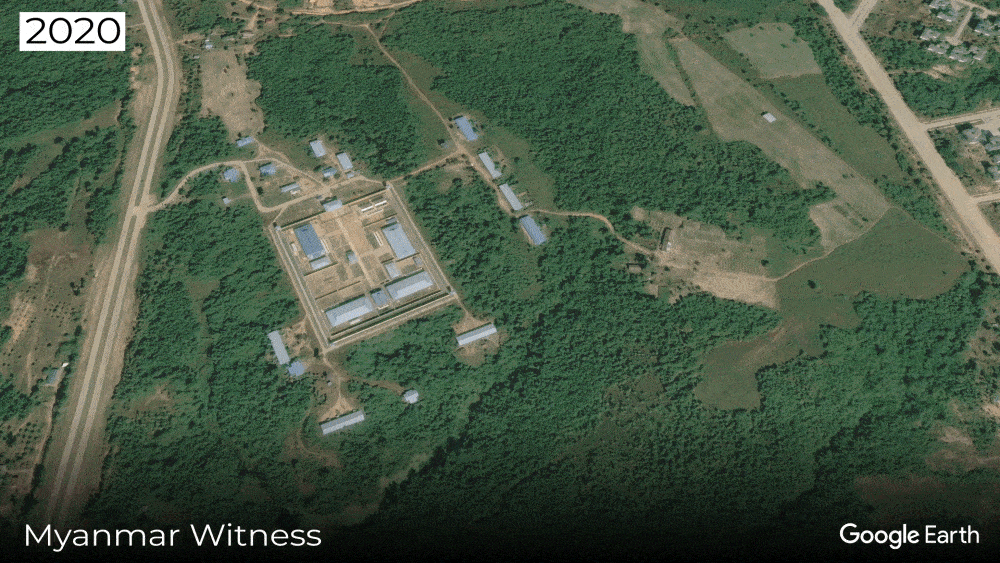
Satellite imagery of Naypyitaw Prison from November 2020 to April 2023. Outlined in white are the new additions and buildings that have been added to Naypyitaw Prison since the coup. (Source: Google Earth Pro)
There have been reports of Aung San Suu Kyi and others being kept in solitary confinement in Naypyitaw. The former leader holds a 27-year prison sentence, after a partial pardon reduced it from 33 years in August 2023. There have been claims that Suu Kyi may have since been moved to house arrest due to her declining health, though this has not been confirmed.
New information on Suu Kyi’s detention in Naypyitaw surfaced in October 2023, after details were shared on X by her pre-coup economic policy advisor Sean Turnell. Turnell, who was also detained in February 2021 for nearly two years, shared an annotated image highlighting where the former leader had been held in solitary confinement, as well as a separate location within the prison where he and other political prisoners were held. Satellite imagery taken over a two-year period reveals clear changes to the detention zone where Suu Kyi was reportedly held.
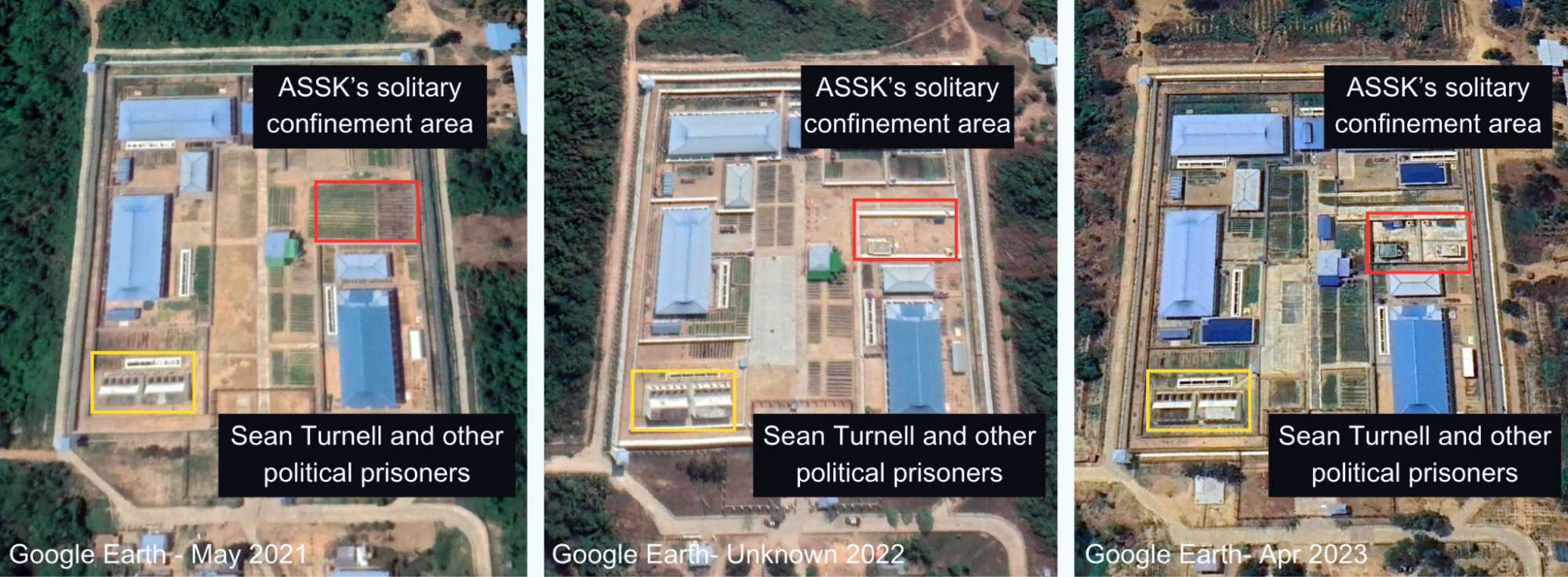
Satellite imagery of Naypyitaw prison between May 2021 and April 2023 shows developments to the claimed detention location of Aung San Suu Kyi (highlighted in red). In yellow is the location where Sean Turnell and other political prisoners were allegedly held. (Source: Google Earth Pro)
Reports of overcrowding and poor sanitation
Human rights organisations such as Human Rights Watch and the AAPP, as well as former prisoners, have repeatedly sounded the alarm over conditions inside Myanmar’s prisons, though little can be gauged from open source monitoring.
Sketches smuggled out of In Seinn Prison in April 2022 revealed a rare glimpse of the crowded dormitories and poor conditions inside. Around this time, former prisoners told Reuters news agency of rat infestations, widespread illness and prisoners having to pay for sleeping space.
Similar concerns have been raised over Myanmar’s labour camps, where prisoners are sentenced to gruelling hard labour, usually in rock quarries or farms.
Myanmar Witness mapped 53 labour camps in total, many of them in rural areas where satellite imagery is less regularly updated.
Satellite imagery of the Inn Pyaung Labour Camp shows the quarry spread across the hillside to the west of the detainment camp facility, where prisoners are held. Significant expansion and changes to the detention facility are visible between 2010 and 2014 – prior to the coup – though the quarry worksite has shown continuous use and growth in the years since, especially since December 2020.
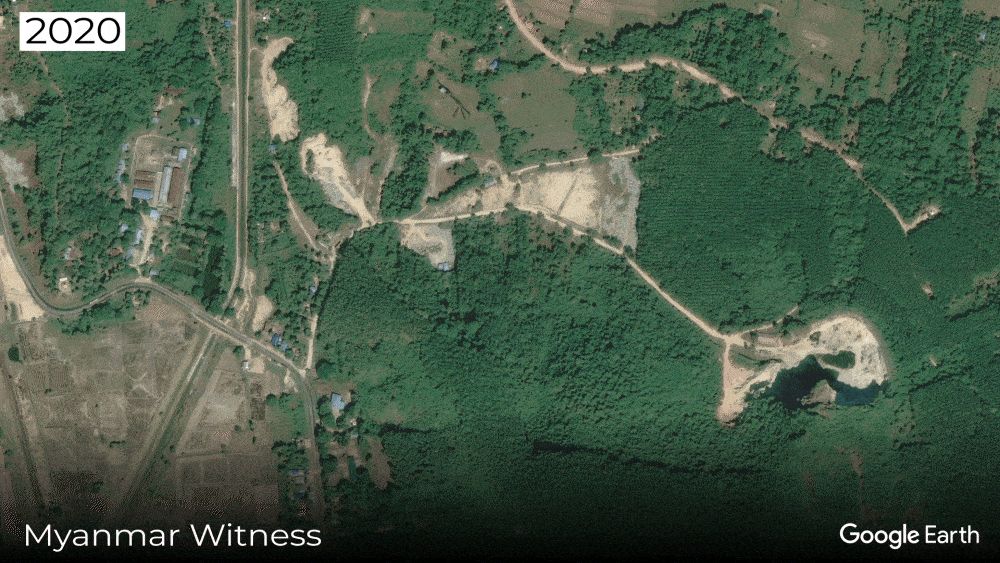
Satellite imagery of Inn Pyaung Labour Camp shows a change in topography over time, particularly on the left side of the quarry worksite. (Source: Google Earth Pro)
Analysis carried out by investigators revealed that while camps did not grow in size in the same way as prisons, they showed signs of continuous activity, with visible changes to the fields or quarries over time – evidence that they are still in use.
Myanmar has a history of controversial detentions, with concerns frequently raised over mass detentions and prisoner rights. Prior to the coup, Human Rights Watch reported on the mass detention of Rohingya Muslims, with 130,000 people reportedly held in “squalid and abusive camps” in Rakhine State, according to a report published in 2020.
Read the full report by Myanmar Witness here.

